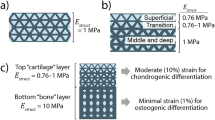Abstract
Overall, autologous bone grafting continues to be the gold standard for the restoration of bone defects while other practices include metallic meshes and plates. These practices are not always suitable particularly when performing reconstructive surgery in the maxillofacial region as the defects tend to be complex in terms of size and shape. These bone defect usually occur due to trauma, infection or a result of oncologic surgeries and therefore the patient requires large amount of bone grafting material [1].
There is a need for alternative methods such as is artificial bone scaffolds with regenerative medicine approaches in order to enable original tissue regeneration. In order to stimulate tissue regeneration scaffolding materials are required to have certain properties such as biocompatibility, adequate mechanical properties and internal and surface topographical features in order to provide specific biological signals to promote cell attachment and proliferation. Ideally, it would also need to be biodegradable and provide sufficient support for both the particular defect area and cellular ingrowth to degrade over time as new bone tissue is formed [2]. This work analyses the mechanical and chemical properties of Hydroxyapatite (HA) - poly(ethylene glycol) dimethacrylate (PEGDMA) and Hydroxyapatite (HA) - poly(ethylene glycol) diacrylate (PEGDA) based composites used as artificial bone scaffold material with internal structures optimized using finite element analysis (FEA) using Hyperworks OptiStruct (Altair, USA) Topological Optimization and manufactured using commercially available additive manufacturing techniques in order to develop a product that can be introduced directly into the patient. The technique allows implants to be custom made, having the right dimensions and the right mechanical properties.
Testing of the ceramic-hydrogel composite include mechanical testing in compression, tension, bending, impact and hardness while chemical analysis include Fourier Transform Infrared spectroscopy (ATR-FTIR) and Differential Scanning Calorimetry (DSC). Morphology was analyzed using Scanning Electron Microscopy (SEM) and Laser Scanning Confocal Microscopy.
Similar content being viewed by others
References
C. Götz, P.H. Warnke, and A. Kolk, Oral surgery, oral medicine, oral pathology and oral radiology 120, 3 (2015).
G. Cama, in Biomaterials for Bone Regeneration, edited by P. Dubruel & S. Van Vlierberghe (Woodhead Publishing, Oxford, 2014), pp. 3–25.
S. Wakitani, T. Goto, S.J. Pineda, R.G. Young, J.M. Mansour, A.I. Caplan, and V.M. Goldberg, J Bone Joint Surg Am 76, 4 (1994).
Y. Liu, J.Lim, and S. Teoh, Biotechnology advances 31, 5 (2013).
D. Puppi, F. Chiellini, A.M. Piras, and E. Chiellini, Progress in Polymer Science 35, 4 (2010).
M. Georgiou, S. CJ Bunting, H.A. Davies, A.J. Loughlin, J.P. Golding, and J.B. Phillips, Biomaterials 34, 30 (2013).
X. Wang, Q. Li, X. Hu, L. Ma, C. You, Y. Zheng, H. Sun, C. Han, and C. Gao, Journal of the mechanical behavior of biomedical materials 8 (2012).
L.M. Geever, C.C. Cooney, J.G. Lyons, J.E. Kennedy, M.J.D. Nugent, S. Devery, and C.L. Higginbotham, European journal of Pharmaceutics and Biopharmaceutics 69, (2008).
S. Wu, X. Liu, K.W.K. Yeung, C. Liu, and X. Yang, Materials Science and Engineering: R: Reports 80 (2014).
R.J. Kane, H.E. Weiss-Bilka, M.J. Meagher, Y. Liu, J.A. Gargac, G.L. Niebur, D.R. Wagner, and R.K. Roeder, Acta biomaterialia 17 (2015).
B. Derby, Science 338, 6109 (2012).
S. V. Murphy and A. Atala, Nature biotechnology 32, 8 (2014).
Author information
Authors and Affiliations
Rights and permissions
About this article
Cite this article
García-Sánchez, M.E., Perez-Naitoh, J.A., Ramirez-Arreola, D.E. et al. Characterization of Ceramic-Hydrogel Composites for Use in Bone Scaffolds Made Using Additive Manufacturing Techniques. MRS Advances 1, 2161–2166 (2016). https://doi.org/10.1557/adv.2016.448
Published:
Issue Date:
DOI: https://doi.org/10.1557/adv.2016.448




